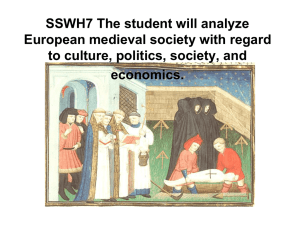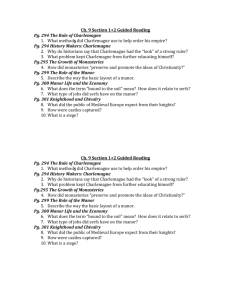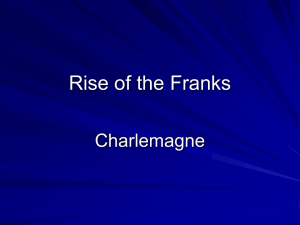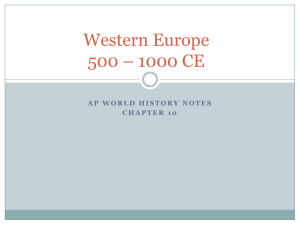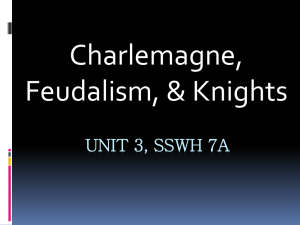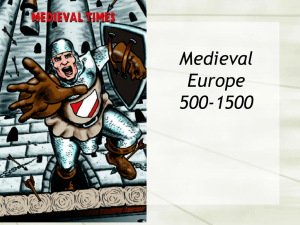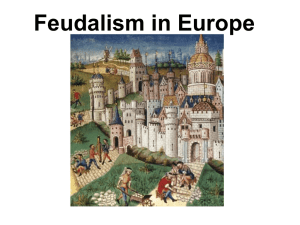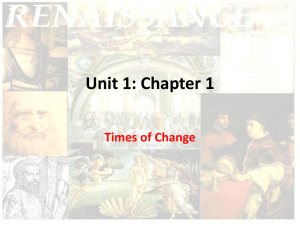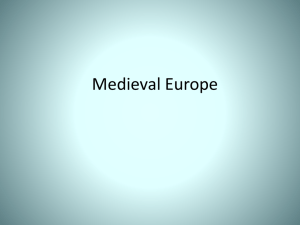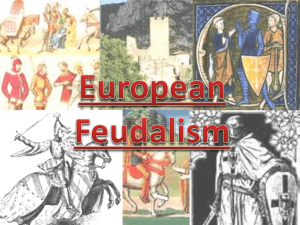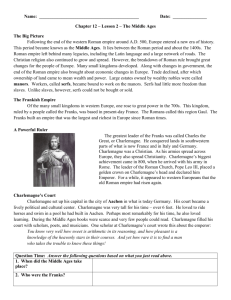1. After collapse of Rome
advertisement
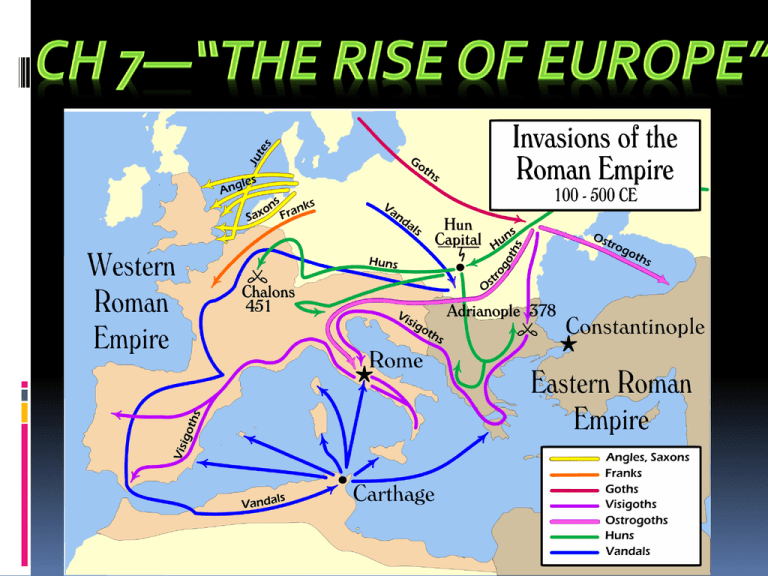
I. EARLY MIDDLE AGES (pg 214) A. Western Europe in Decline: 1. After collapse of Rome: A. Germanic peoples built on Rome’s: i. Use of Latin Language ii. Classical ideas iii. Christianity b. From 500-1000AD=chaos in Europe=Dark Ages* 1. Due to: a. Decrease in trade b.Depopulation of cities/towns c. Classical learning stopped B. Rise of Germanic Kingdoms 1. Their Culture (Goths, Visigoths, Vandals, Saxons, Franks) a. Farmers & herders=few cities or written laws b. Kings elected by tribes=small kingdoms 2. Franks* Extend Their Power a. King Clovisconquered all of Gaul (France) i. Converted to Christianity=ally of pope 3. Muslim Empire Threatens Europe a. Spread from Middle East b. Charles Martel* & the Battle of Tours*-732AD i. Franks & Muslims in France =Frank victory stopped Muslim advance Martel’s victory at Tours— 732AD C. Age of Charlemagne* 1. Charles the Great=Charlemagne (grandson of Charles Martel) a. United parts of Europe: France, Germany, Italy 2. A New Emperor of the Romans a. Charlemagne helped Pope Leo III w/ rivals =proclaimed him Emperor of the Romans =a reunited Christian Europe=Christendom b. =angered emperor of Eastern Roman Empire in Constantinople (the Byzantines) Charlemagne’s Tomb of Gold The coronation of Charlemagne Until his death in 814, Charlemagne ruled an empire which included modern Catalonia, France, western Germany, the Low Countries, and northern Italy. (In Green) 3. Creating a Unified Christian Empire a. Charlemagne helped to spread Christianity b. Appointed nobles (rich landowners) to rule local regions 4. Revival of Learning a. Charlemagne viewed education as way to unify kingdom b. Brought in scholars, created schools D. Europe After Charlemagne 1. Charlemagne Died in 814AD a. =son Louis I took throne=empire split in 3 Charlemagne’s Crown 2. Charlemagne’s Legacy: a. Extended Christian civilization b. Further blended Germanic, Roman & Christian culture=Medieval c. Set up strong efficient govt 3. New Waves of Invasion a. Muslims b. Magyars* in Eastern Europe 4. Raiders from the North a. Vikings* from Scandinavia i. Expert sailors ii. Burned & looted = barbarians 1. Targeted monasteries (for gold) & port towns 2. Berserkers=fiercest warriors iii. North America in 1000Ad 1. Vinland (=Newfoundland, Canada) 2. Leaf Erikson iv. Polytheistic v. “Blood Eagle” ( or winging) II. FEUDALISM & THE MANOR ECONOMY A. Feudalism*: A Political System Power #s KING Lord: or Leige Lord Vassals: included knights Serfs: 95% of Europe 2. Mutual Obligations a. Feudal Contract*: i. Vassals granted a fief* by lordincluded serfs on the land=40 days of military service per year + rent money B. World of Knights & Nobles 1. Knights & Warfare a. Knights*=mounted warriors, were Lords b. Trained from age 7 (?) c. Armored, on horseback, swords 2. Castles & Defense a. Built on high ground, fortified, moats C. The Manor*: An Economic system 1. Lords & Peasants: Mutual Obligation a. Peasants=Serfs* (bound to land of a lord or vassal) 1. Little Freedom Lord/Vassal +Give some use of Land to serfs -protect serfs + tax$ from manor +military duty from serfs Serfs -had to work Lord/Vassals land -made repairs to property -ask permission to marry/travel -paid fees (taxes) to lord/vassal +couldn’t be forced off manor =guarantee of food, housing, protection, & use of land 2. A Self-Sufficient World a. Everything needed produced on manor 3. Peasant Life a. =Harsh b. Child-labor c. Disease=few lived beyond 35 years d. Christianity & its holidays III. THE MEDIEVAL CHURCH (pg. 225) A.The Church Dominates Medieval Life 1. Role of the Parish Priest a. Celebrated mass & administered sacraments* b. Explained Bible=had to be able to read Latin=illiterate serfs c. Some ran parish schools (to teach Christianity, NOT read/write to serfs 2. Importance of the Village Church a. =center of life b. Had to pay a tithe*=10% of income c. Pilgrimages Pay 10%=receive sacraments (baptism, marriage, communion, last rites)=go to heaven DON’T PAY= 3. Rise of Cathedrals: POWER #s POPE Bishops: Cathedrals Priests: village churches Parishioners: paid tithes to support whole pyramid As the photo above of Canterbury Cathedral shows, cathedrals were huge buildings - they were major long term building projects and their cost was huge, showcasing the wealth of the Church. Lincoln Cathedral. Lincoln in England is an example of a cathedral city. a. Gothic style of architecture 4. Church Attitudes Toward Women a. Exclusion of women as priests, bishops, pope b. Ideal Woman: Mary, mother of Jesus B. Church Power Grows 1. Church’s Role in Society a. Pope had Papal Supremacy* i.=had authority over Kings & emperors even though secular* (non-religious) b. Bishops/Archbishops=high clergy i. Had own manors ii. Many rich due to tithes of poor parishioners 2. Religious Authority & Political Power a. To attain salvation (go to heaven): i. Do good works ii. Believe in Christ iii. Receive Sacraments administered by the Church b. Canon Law*=own church laws w/penalties i. Threat of excommunication* or the interdict* 3. A Force for Peace a. Truce of God=no fighting Friday through Sunday or on religious holidays IV. ECONOMIC RECOVERY SPARKS CHANGE (pg. 231) A. Agricultural Revolution 1. Technology Improves Farming a. Use of iron plows=got deeper into soil b. New harness let horses pull plow=faster =more crops harvested=more food (& tax $) 2. Production & Population Grow a. More land cleared for farming b. Crop rotation=3 Field System (grain, legumes, fallow) =more crops=more food =higher population 1000-1300AD Europe’s population tripled! This is the start of the Medieval Age. B. Revival of Trade & Travel 1. Trade Routes Expand a. Less threat of warfare & invasion b. People wanted goods from elsewhere: silk, spices from Asia c. Trade centers: i. Constantinople ii. Venice iii. London iv. Antwerp =Ports 2. Growth of Towns & Cities a. Trade fairs & markets=many became cities b. Wool trade profitable for Italy & Belgium c. Merchant’s Charter* i. rights of town written down=people pay taxes to king or lord ii. One Day Clause for runaway serfs C. Rise of the Middle Class* 1. =the group between nobles & peasants P # Nobles (upper class): kings, lords, vassals=rich landowners Middle Class=(merchants, artisans=Guild Members) Peasants/Serfs (lower class) 2. Role of Guilds* (for merchants & artisans) a. Early labor unions b. Example: Free Masons (stone workers) 3. Becoming a Guild Member: Master Journeyman* Apprentice: for 7 years CHESS: the oldest game in the world & Medieval Society I. Pawns = serfs a. More of them than any other piece on the board b. Like the pawn serfs were often left unprotected c. They worked hard and died young d. They could be traded, used as a diversion, or even sacrificed to allow the landowners to escape harm II. Castle piece/Rook = home or refuge a. Is a home or refuge in medieval times b. In chess, each side has 2 castles, or rooks, as they are often called. III. Knight =professional soldier of medieval times a. Job was to protect persons of rank b. Protects person of rank c. Knights are more important than pawns, but less important than bishops, kings, or queens d. Purpose of game is to protect the more important pieces IV. Bishop = the church a. Rich and mighty force in Medieval times b. Played a large part in every person’s life c. Bishop was the name for a priest in the Catholic church who had risen through the ranks to a more powerful position V. Queen a. Most powerful piece on the board i. Women of medieval Europe were powerful i.King often guided by her advice ii.She played games of intrigue at court\ b. Kings could set aside the queen with the approval of the church c. Queen would either work for or against the king and often held more power VI. King a. The tallest piece b. Well defended c. In medieval time – surrender of the king the king means the loss of the kingdom d. It was everyone’s advantage to keep him safe e. The most important piece (even if not most powerful)
